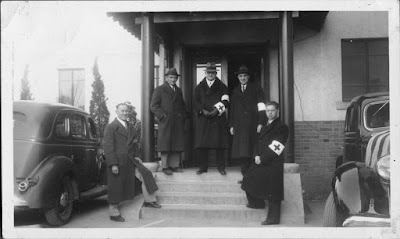Teaching Genocide and World War II Through the Lens of East Asia
 |
| Photo Caption: John Rabe and the Nanjing Safety Zone Committee (Yale Divinity School Library, Ernest H. Forster Papers) |
Written by Addie Male, history teacher, Upper House Humanities Department Chairperson, and dance ensemble advisor at Millennium Brooklyn High School in Park Slope, Brooklyn.
____________________________________________________
I have long wanted to develop and teach a unit on the Nanjing Atrocities for my students at Millennium Brooklyn High School. As a high school history teacher with an undergraduate degree in East Asian Studies, I see it as an important history that we seldom teach in the United States.
It was wonderfully serendipitous last spring when, shortly after my proposal was approved for a new, senior elective entitled, “Turning Points in Global History,” Facing History and Ourselves offered a one-day workshop on this very subject at the China Institute. Attending this workshop very much informed the planning and teaching of this unit, within the umbrella of a course largely focused on case studies of genocide and atrocities and subsequent efforts of truth and reconciliation.
Because Nanjing is often untold within the context of WWII, this was the perfect case study to explore with my students, buttressed between Armenia and Rwanda. I was eager to attend this workshop, which reacquainted me with the historiography of China’s relationship with Japan and provided me with a foundation for teaching this unit. Using Facing History’s resource guide, The Nanjing Atrocities: Crimes of War, we were able to more deeply explore the different aspects of this history while being introduced to images, short clips, and engaging teaching activities that I could take back to my students. I found that the powerful and compelling primary voices in the resource, created space for my students to delve into an unfamiliar event in history in an accessible and meaningful way. They were then able to develop a deeper understanding of the many facets of this overlooked but essential study in attempting to answer our core questions surrounding genocide and atrocities.
But this workshop also prepared me to tackle the difficult aspects of teaching genocide in the classroom. I profoundly appreciated Facing History’s acknowledgment that this history is sensitive, particularly the victimization of women during wartime atrocities. This enabled me to delve into women’s experiences with my students and expose them to the voices of these survivors. Rather than shy away from this arena, thereby further marginalizing these voices, the workshop empowered teacher participants to include rape as a weapon of warfare in the teaching of Nanjing.
Just as important as acknowledging the victims’ experiences is the focus on rescue and resistance. This was a core facet of the workshop and instrumental in the planning and execution of the teaching of this unit. Students come to understand that targeted groups in genocide and wartime atrocities are not passive victims but survivors who actively engage in resistance of their oppressors. One activity that aided in this understanding was the creation of resistance newsletters, fictitiously published from the Nanjing Safety Zone but based on readings and content work from the Facing History curriculum guide. Working in groups, students were responsible for including: a letter to international leaders from John Rabe, an op-ed piece based on the accounts of Tsen-Shui Fang, and an artistic rendering depicting the realities faced by Chinese in the Nanjing Safety Zone. Notions of choosing to participate, resisting, and seeking justice—name stays of Facing History’s work—are also essential components of my course work with my students.
Rescue and resistance, and the aftermath, were, frankly, aspects of this time period that I was not fully aware of but because of the workshop I felt confident infusing this work into our study of the Nanjing Atrocities. While this was difficult and challenging work to explore, it was necessary to understanding the importance of resistance movements and holding perpetrators accountable. Specifically, the clip on the Tokyo War Crimes and readings such as “Accepting Defeat” and “Rebuilding” were necessary and empowering for the students. By understanding how and why atrocities are committed, and met with active resistance, my students were better able to understand change is possible.
A cornerstone of my teaching is that by studying historical periods such as the Nanjing Atrocities students can make connections to domestic and international conflicts of today and recognize they can demand change and be the agents of change themselves. Teaching this unit exposed my students to a topic not typically included in WWII units of study, while urging them to explore essential questions of why such atrocities occur. Equipped with this knowledge, they can make positive choices that can lead to a more compassionate world.
Do you want to learn how to broaden your students' knowledge of World War II beyond Europe? Join us on April 24 for the online workshop, "Teaching World War II in East Asia."
Comments
Post a Comment